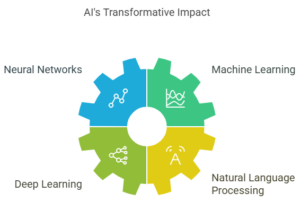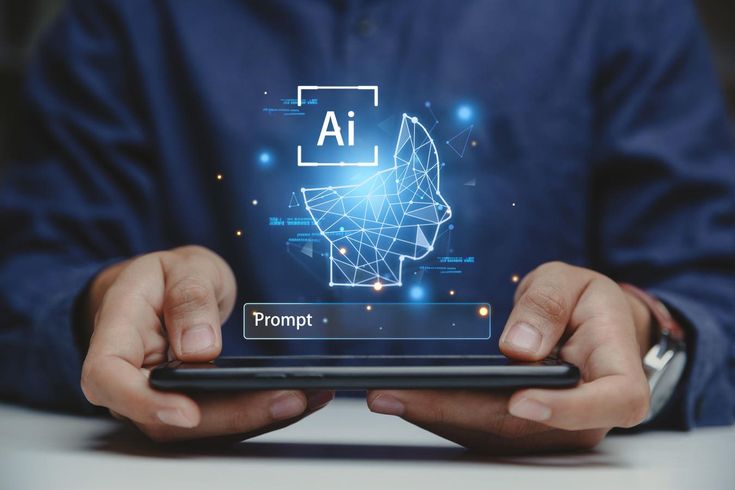Discover how artificial intelligence (AI) as a general-purpose technology is revolutionizing industries worldwide. Learn about AI-powered solutions, machine learning, and more in this detailed guide.
1. Introduction: What is Artificial Intelligence General Purpose Technology?
Artificial Intelligence (AI) has been changing the face of many industries, including manufacturing, healthcare, and even manufacturing. If we talk about AI as a general-purpose tech is a reference to the fact that it can alter almost every aspect of life for humans. The term “general-purpose” refers to technologies that can be used across a wide range of areas with a broad impact on different sectors.
In this piece, we’ll explore how Artificial Intelligence as a general-purpose technology impacts the industries it is affecting, as well as its many applications as well and how it will shape the future of communication, work as well and technology. By combining neural networks, machine learning, deep learning, as well as natural processing of language processing (NLP), AI-powered technologies have revolutionized the way people live and work.
2. What Makes AI a General-Purpose Technology?
AI can be used as a general-purpose technology, and could be utilized in multiple areas as electricity is, as well as the Internet. It isn’t restricted to just one particular task, and can be employed to address a wide range of issues across various sectors. This flexibility is a hallmark of technology that is general-purpose, and they are the foundational tool to advance multiple fields.
We saw similar transformational technologies. Like, for instance, the advent by the Internet was was thought to be a niche technology and then it came into use across various different industries. In the same way, AI is now becoming vital to the advancement of fields such as finance, healthcare, transport, education and entertainment.
3. The Role of Machine Learning in AI
Machine Learning (ML) is among the most well-known elements of AI. It is the process of developing algorithms that enable computers to “learn” from data, increasing their efficiency over time. Machine learning is the most fundamental component of AI that allows computers to make their decisions based on patterns and the insights gathered from huge databases.
Key Features of Machine Learning in AI
- Learning based on data: AI algorithms are taught on a vast amount of data to find patterns and predict outcomes, without being programmed in advance for each assignment.
- Improved in the course of time The system is able to process more information and makes more decisions, it’s decision-making abilities improve.
- Wide-ranging applications from recommender systems such as Netflix to fraud detection systems in banking, machine learning is an integral part of many different areas.
| Machine Learning vs. Traditional Programming |
|---|
| Machine Learning |
| Learns from data to make decisions |
| Can improve over time |
| Highly flexible and adaptive |
| Used for complex tasks like speech recognition |
Machine learning enables intelligent systems that continue to evolve, offering AI solutions in various industries.
4. Neural Networks: Mimicking the Human Brain
Neural networks, based on the anatomy of the human brain are essential in the ability of AI systems to carry out tasks such as image recognition natural processing of language (NLP) as well as complicated decisions. Neural networks are composed of interconnected layers (also known as neurons) which process data by stages, and adapting and learning as more information is fed to the system.
Applications of Neural Networks
- Images and Speech Recognition Neural networks are utilized to recognize faces and in speech-to-text technology.
- Predictive Analytics Neural networks assist in the making of predictions in fields such as marketing and finance through the recognition of patterns within large data sets.
| Application of Neural Networks | Industry Impact |
|---|---|
| Facial recognition | Enhanced security in airports, phones, and other services |
| Autonomous vehicles | Used to analyze real-time road data and make driving decisions |
| Medical imaging | Aids doctors in diagnosing diseases with higher accuracy |
Neural networks have made significant strides in making AI more intuitive, allowing it to “think” and adapt like the human brain.
5. Deep Learning: Advancing AI’s Capabilities
Deep learning, which is a component of machine-learning, utilizes complex neural networks that have many layers of analysis to process massive amounts of data. Deep neural networks are capable processing extremely complex patterns and performing complex tasks, such as translating languages as well as natural language understanding as well as visual recognition.
Why Deep Learning is Important
- Automatization of complex tasks. Deep learning can allow computers to complete tasks that traditionally required human brainpower, like the translation of languages or recognising the appearance of objects.
- Accuracy Large datasets as well as robust algorithms deep learning has led to improvements in fields such as self-driving cars as well as healthcare diagnostics.
| Deep Learning vs. Traditional AI Methods |
|---|
| Deep Learning |
| Requires large datasets for training |
| Can handle unstructured data (images, text, etc.) |
| High computational cost |
Deep learning is a key factor in AI’s ability to perform more human-like tasks and provides powerful AI-powered solutions.
6. Natural Language Processing (NLP): Enabling Human-AI Communication
Natural Language Processing (NLP) is a field of AI that focuses on the interaction between computers and human languages. The technology allows computers to comprehend and interpret human languages, making the interactions between humans and machines easier and natural.
NLP in Action
- Voice Assistants: Siri, Alexa, and Google Assistant use NLP to comprehend and respond to commands from voice.
- Chatbots: NLP powers chatbots, which provide support to customers or help with online questions.
- Analyzing Sentiment Business makes use of NLP to study the feedback of customers and reviews to determine the sentiment of customers about their products or services.
| NLP Applications | Industry Examples |
|---|---|
| Customer service chatbots | Banks, e-commerce platforms |
| Sentiment analysis | Social media monitoring, market research |
| Translation services | Google Translate, international communications |
NLP is pivotal in making AI more accessible and human-friendly, bridging the gap between human communication and machine understanding.
7. AI-Powered Solutions: Transforming Industries
AI-powered solutions make use of artificial intelligence to help companies tackle problems, improve operations and boost customers’ experiences. They rely on neural networks, machine learning and deep learning in order to improve processes, and also provide analytics based on data.
Examples of AI-Powered Solutions
- Health: AI assists in diagnosing illnesses, suggesting treatments as well as predicting the outcomes of patients.
- Financial: AI algorithms detect fraud, make trading more efficient, and help optimize the financial strategy.
- Retail AI aids with inventory management, personal shopping experiences, and demand forecasting.
| Industry | AI-Powered Solutions |
|---|---|
| Healthcare | Diagnostics, personalized treatment plans |
| Finance | Fraud detection, investment strategies |
| Retail | Personalized recommendations, inventory management |
AI-powered solutions are streamlining operations and making businesses smarter, faster, and more efficient.
8. Cognitive Computing: Making Machines Think Like Humans
Cognitive computing is one of the branches of AI that seeks to replicate the human mind within a machine. With the help of neural networks and algorithms cognition-based computing systems are able to comprehend how to reason, think, and gain knowledge through experiences in the same way that humans.
Cognitive Computing in Action
- Decision Support System: They help companies make better decisions through analyzing the vast amount of information.
- Personal Assistants: Cognitive computing can be employed in virtual assistants, making their interfaces more intelligent and nimble.
| Cognitive Computing vs. Human Thinking |
|---|
| Cognitive Computing |
| Processes vast amounts of data quickly |
| Can adapt and learn from experience |
| Applied to decision-making in businesses |
Cognitive computing continues to improve the human-computer interaction by making machines more capable of reasoning and understanding.
9. FAQs About Artificial Intelligence as a General-Purpose Technology
Q1 What are the major advantages of AI as a technology that can be used for all purposes?
AI as a general-purpose technology can provide greater efficiency, increased automation, and the capacity to make decisions based on data. This helps businesses increase productivity, decrease costs, and invent ways previously thought impossible.
Q2: What is AI utilized in health care?
AI is used in healthcare to aid in diagnosing, personalized treatment as well as predictive analytics and monitoring patients. It is able to analyze medical pictures and predict outbreaks of disease as well as assist with the discovery of drugs.
Q3: Will AI replace human jobs?
Although AI can automate a variety of tasks however, it can also open up fresh opportunities. AI technology could assist workers to make more informed choices, and relieve workers from monotonous tasks However, human creativeness and emotional intelligence remain vital in many fields.
10. Conclusion
Artificial Intelligence, a general-purpose technology, is changing our world as we know it. From machine learning and deep learning, to NLP and cognition computing, AI has revolutionized industries all over all over the world. Integration of AI-powered technologies in everyday activities isn’t simply increasing productivity, it is it is also allowing new opportunities in the field of innovation and development. While we push the limits of the possibilities that AI can do, it will surely be shaping the future in thrilling and inconceivable ways. For more detailed insights into how AI is shaping industries, visit MIT’s AI Research.


